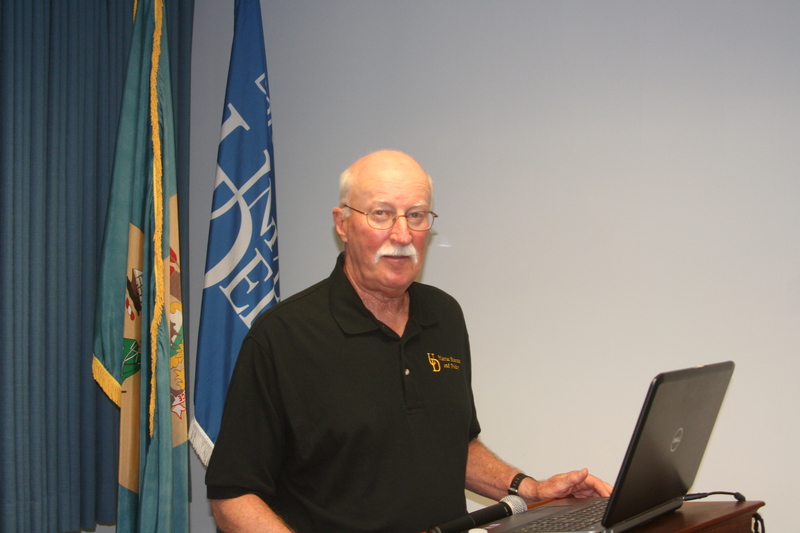Charles Epifanio details the wet and wild story of marine science

Charles Epifanio has created a presentation chronicling the University of Delaware’s ever growing academic prominence to natural science.
“This talk is not gong to be dry, no pun intended,” joked Epifiano.
“History of Marine Science at the University of Delaware: A Wild, Wet and Windy Story,” looks back at the marine college’s changing names and from its meager beginning to its ranking today among the top 12 marine programs in the country.
Epifanio gave a presentation July 18 in the Cannon Laboratory on the marine college’s Hugh R. Sharp Campus in Lewes, and no one fell asleep.
“It’s been 65 years of adventure and hard work, and for all my colleagues and students over the years, truly it has been an adventure and really hard work and also a little bit of serendipity which, in any institute or organization, is part of the show,” Epifanio said.
Starting with the present, he said the School of Marine Science and Policy is a unit within the College of Earth, Ocean and Environment.
“Sometimes it’s referred to as the college of earth, wind and fire, but that doesn’t happen too often,” he said jokingly.
The college has 80 undergraduate and 100 graduate students and a faculty of 45, which is 4 percent of the university’s 1,172 faculty members.
In its history, the university has bestowed 34 Allison Awards, the most prestigious award a professor can receive. Four College of Earth, Ocean and Environment professors have received an Allison.
“That means we represent 12 percent of the Allison professors, even though we’re only 4 percent of the faculty," said Epifanio.
“So, the question becomes how did this pipsqueak little unit, the College of Marine Science and Policy, become such a high-achieving program within the UD? That’s the wild, wet and windy part. That’s what I’m here to tell you, folks.”
|
Charles Epifanio: marine scientist, college historian Epifanio, 68, earned a doctorate in zoology from Duke University. During his career at the University of Delaware, he has served as a researcher, professor, associate director, interim director and associate dean. In 2011, he was inducted into the Delaware Maritime Hall of Fame. He is an expert in the growth and development of fish and crustaceans, and his research has focused on biological and physical dynamics that affect yearly variations within populations. Currently, he is researching models to increase blue crab numbers by the addition of a new group of juveniles to a population and factors that affect population growth. He also studies invasive species of crabs, particularly from Asia, such as Chinese mitten crabs, and the effects they have on local crab populations. Epifanio said although he’s seen many changes in the university’s marine program, what has changed most is the surrounding community - population growth, land use, demographics - and problems that have arisen from those changes. “It’s been impressive to watch the [marine] program grow and evolve to keep in lockstep with these problems and policies,” he said. |
Before going further, Epifanio said he needed to be cautious because looking into the audience he could see a lot of “fact-checkers.”
“I’m going to try to make this an interesting story, and like any good storyteller, I might embellish on things a little bit. But I’m not telling you any lies. So, where did we come from? Not from money,” he said.
In 1948, a group of local fishermen concerned about a drastic decline in Delaware Bay catches approached the Delaware General Assembly for help. Epifanio said the fishermen believed UD could come to their aid.
The General Assembly responded by allocating $30,000 to set up a marine program in the university’s Department of Biological Sciences.
The Early Years - 1950-60
Epifanio said historical presentations require providing a lot of dates that need historical context, so he used baseball World Series winners for sports fans and Academy Award Best Picture winners for those into popular culture.
“In 1950, it was the Yankees. They swept the Phillies 4-0. In 1950 Best Picture was 'All About Eve.' I’m sure, you know, just like me, that’s one of your favorite movies. But it did have Bette Davis in it,” he said, generating laughter.
For “numbers wonks,” Epifanio gave information about Sussex County. For instance, in 1950, the county had a population of 61,000.
“Most of those hardy souls lived in the western part of the county. That’s important to know,” he said.
In the summer of 1951, L. Eugene Cronin became the college’s first director. The lab was in Lewes High School’s basement. Cronin came from Chesapeake Biological Lab in Solomons Island, Md.
“In 1951, the World Series champs were the New York Yankees, again, and they beat the New York Giants. The Best Picture that year was ‘An American in Paris,’ starring Gene Kelly, Leslie Caron and Oscar Levant.”
He said when the school year started, the program was summarily kicked out of the high school’s basement.
Cronin found a temporary home at Bunting’s Landing on Pilottown Road near the De Vries Monument adjacent to the Lewes-Rehoboth Canal.
From 1952 to 1956, the laboratory was in an old building that had once been a restaurant.
“No marine lab is a marine lab without a vessel. Our first vessel was the RV Acartia. It was purchased for the princely sum of $2,500. It was a 45-foot, wooden fishing vessel. She served for 12 years, and according to a quote from one crew member, ‘We wore her out,’” Epifanio said.
In 1953, the Yankees won their fifth consecutive World Series, beating Brooklyn 4-2.
“Best Picture for 1953 was ‘From Here to Eternity’ - Burt Lancaster, Montgomery Clift, Deborah Kerr, Frank Sinatra and Donna Reed.
“Who can forget the famous love scene with Burt Lancaster and Deborah Kerr. Well, this is the wild and wet part,” he said, laughing when he showed a photo of the famous kissing scene with Lancaster and Kerr stretched out on a beach. “I won’t say anything more about that.”
He said Cronin’s primary job was finding a more permanent site for the marine lab. The U.S. Army Corps of Engineers offered a site on Beach Plum Island, which they created from Roosevelt Inlet dredge spoils.
“That was where the first lab was built. It was out on a barrier island. That construction was more than just hammers and nails and bricks and mortar. There was no power out there; there was no water, and there was no sewage. All of those things had to be attended, and they were,” he said. Cronin did all of the legwork to build the lab, but in 1955, in the middle of the project, he returned to Chesapeake Biological Lab to be its director.
Carl N. Shuster replaced Cronin. “Some of you may have heard of Dr. Shuster. He has become a world expert on the biology and ecology of horseshoe crabs,” Epifanio said.
In 1955, the Brooklyn Dodgers beat the Yankees 4-3 to win the World Series, and Best Picture award went to "Marty," starring Ernest Borgnine.
“Sussex County by this time now had 67,000 hardy souls, again mostly in the western part of the county. Here I’ll give you some new data. Starting with a benchmark of sea level in 1950, I’m going to begin to tell you what sea level was like on different dates in Delaware Bay. In 1955, sea level had risen 0.6 inches. So, it’s going up,” he said.
A new facility, the M. Haswell Pierce Laboratory, was dedicated in 1956. Pierce, a Milford resident, was interested in “marine stuff,” Epifanio said, adding that he was also part owner of the trawler American Beauty. He said the facility became known as Bayside Lab, and it served as the university’s main marine program lab until 1975.
Shuster left in 1962 to take a position as director of Rhode Island’s Public Health Service Lab, and Charles Wilbur replaced him.
“Of all the people that I researched, he was the one I couldn’t find anything about. I found out a little bit about him from interviewing folks in the audience, but I couldn’t find a picture of him. I found out he lived in Newark year-round and rarely came to Lewes,” Epifanio said.
He said Franklin Daiber, a junior professor, was managing the facility, and Wilbur was studying monkey physiology in temperature-effect experiments.
“The best thing I could come up with to demonstrate the mysteriousness of Charles Wilbur was this photo,” Epifanio said, showing a picture of The Lone Ranger and Tonto.
“There’s Charles,” he said, circling the Lone Ranger, “And there’s his faithful companion Frank Daiber who was actually running the place,” Epifanio deadpanned, circling Tonto.
“In 1962, the World Series champs now again were the evil empire New York Yankees beating the Giants.” He said baseball was changing dramatically, with the Giants and Dodgers moving to the West Coast.
The Best Picture award went to "Lawrence of Arabia," starring Peter O’Toole, Alec Guinness and Anthony Quinn. Sussex County’s population had reached 73,000, and there was a slight shift in growth toward the east. Delaware Bay sea level had risen 1.2 inches relative to the 1950 benchmark.
“In 1965, the university was able to come up with another vessel, a donated vessel, the R/V Wolverine, a 46-foot converted motor sailer. She served us for more than 25 years.”
In 1967, during what Epifanio called Musical Chairs at the Top, Daiber replaced Wilbur after he resigned to take a job at Colorado State. “It must have been a better place to study monkeys,” Epifanio said.
In the World Series, the Cardinals topped the Red Sox 4-3, and Best Picture went to "In The Heat of the Night," starring Sidney Poitier and Rod Steiger.
In 1968, the university acquired the R/V Skimmer, a 40-foot, aluminum, custom-built vessel. “This was the first vessel we had at the University of Delaware that was built and designed and commissioned explicitly for marine research," said Epifanio.
“She served us for more than 25 years, and five of those years were in Costa Rica on a project I was deeply involved in.”
He said the R/V Skimmer was transported aboard a banana boat to the Panama Canal, where she was put in the water, passed through the canal, and motored up the Pacific Coast to Costa Rica.
“She came all the way back from the Pacific Coast of Central America on her own bottom with two of our crew members. I wish I could have been a fly on the wall. There are some great stories there,” Epifanio said.
Next: The Building Years - 1969-2005. Epifanio said 1969 “was probably the most important year in our history.”























































